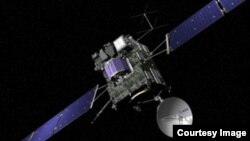It's a proud moment for the Paris-based European Space Agency (ESA).
After a decade-long six-billion-kilometer chase, its Rosetta orbiter made history Wednesday, finally catching up with Comet 67P halfway between the orbits of Jupiter and Mars.
The ESA's $1.7 billion probe is the first spacecraft to rendezvous with a comet.
After entering orbit 100 kilometers above the surface of the 67P/Churymov-Gerasimenko comet early Wednesday morning, at a distance of more than 400 million kilometers from Earth, images soon emerged that showed the vessel heading toward a massive rock spinning in the starry dark.
Rosetta will escort Comet 67P for the next year and observe it as it heads towards the sun. The highlight of the mission will come in November, when Rosetta will release a small probe that will attempt to land on Comet 67P — the first ever spacecraft to accomplish such a feat.
For recently retired mission manager Gerhard Schwem — reached by phone from ESA's operations center in Germany — Rosetta's rendezvous on Wednesday is not only a first in space history, but a career milestone.
"For me it's a great day," he said. "I've been working on this cometary cornerstone, as it’s called in the agency, since '85. It's the span my professional career ... so it's quite great that I started with something that's now basically accomplished."
For Dr. Stephan Ulamec, Rosetta Project Manager, the landmark achievement, for all of its technological sophistication, is about addressing very basic questions.
"The challenge is that we know almost nothing about the comet, and we knew even less when we built the probe," he said. "We didn't know how the surface [of the comet] looks like, whether it is soft or hard like ice. The day-night cycle is fairly known. But until recently we didn't even know what the comet looks like, what shape it has.
"And that is the big difference to missions where we land on the moon or on Mars, where we have a pretty good notion of the body we intend to land on," he added.
Scientists believe comets contain the origins of life on Earth — the Rosetta probe is named after the stone that helped unlock the hieroglyphic language of the ancient Egyptians — delivering water and other essential components as they slammed into the planet's surface.
According to Schwem, the project's ultimate goal is to dig back in time — a sort of "space archeology" — to the very origins of the Solar System.
"Comets are not only fascinating objects ... when it's bright enough and you see the tail in the night sky, but comets for us are very, very important," Schwem said. "They can contain the material that has been preserved, like in a deep freeze, since the planets and sun formed 4.6 billion years ago."
With the probe now orbiting around 67P, Rosetta's scientists will begin mapping the comet's surface with a range of instruments. They'll also begin studying the composition of gas emitting from its surface as the comet draws closer to the sun. If Rosetta's small lander successfully touches down this fall, tools aboard the 220-pound landing unit will analyze material below the comet's surface along with its internal temperature fluctuations as it hurtles through space.
Although the Rosetta mission is officially expected to wrap up by the end of 2015, Schwem says the probe's 31-month hibernation, which ESA technicians concluded in January, conserved enough energy to allow the craft to produce new information and updates into 2016.
Rosetta has traveled over six billion kilometers since blasting off from earth in March 2004. It made a series of fly-bys of Mars and Earth so it could pick up speed and positioned itself into the same orbital path as Comet 67P.
The US National Aeronautics and Space Administration, or NASA, also contributed experts and instruments to Europe's Rosetta mission.
VOA correspondent Lisa Bryant contributed reporting from Paris.









